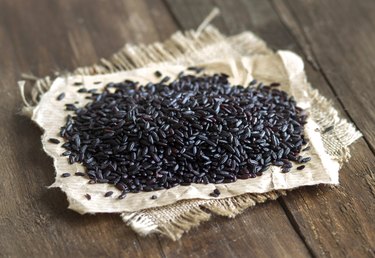
Plain white rice typically takes a back seat in most dishes, quietly playing a supporting role and leaving the focus on brighter, more flavorful ingredients. That's not at the case with black rice. Its nutty flavor and vivid color make it a star ingredient in its own right, a worthy complement to your freshest vegetables and boldest sauces. Black rice cooks as easily as any other form of the grain, making it an easy upgrade for your favorite recipe.
A World of Color
Video of the Day
White rice is pale simply because its outer layer of bran, rich in fiber and nutrients, has been milled away. That's not the case with black rice, or with brown or red rice. These are whole grains, rich in B-vitamins and antioxidants. The colorful outer layer of black rice is actually a deep, eggplant-like purple created by compounds called anthocyanins. These are the same organic chemicals that give grapes, blueberries and blue potatoes their distinctive hue. Chinese black rice, or "forbidden" rice, is similar in texture to conventional long-grain brown rice. Thai black rice is a form of sticky rice, and has a different texture when cooked. If you're not sure which one you have, look at it closely -- Chinese rice is uniformly dark, while Thai rice contains some brown and red kernels.
Video of the Day
Patience Is a Virtue
Whole-grain rices cook more slowly than white rice because the bran layer impedes the flow of moisture into the grain. Black rice has an especially robust bran layer, so cooking times can be as long as 45 to 60 minutes. Aside from the time involved, it cooks much like any other rice. Use approximately 2 cups of water for the first cup of rice, and slightly less for each additional cup. Once the rice is cooked, let it rest for 10 minutes before fluffing the rice. This provides time for its starches to firm slightly, so the grains will separate nicely instead of mushing together.
A Few Crucial Tips
You can shorten the cooking time for black rice by soaking it, as you would with dried beans. Cover it in cold water to a depth of an inch or two, and let it soak for 4 hours or as long as overnight. Drain and rinse it, then cook it normally for 20 to 25 minutes. You'll need to use less water, only about 1 1/2 cups per cup of rice. The finished rice will be lighter and fluffier. If you don't have time to soak the rice, simply rinse it well in a colander. This does nothing for the cooking time, but rinses away surface starch that makes the rice gluey. It's important to note that the rice's pigment is water-soluble and makes stubborn stains, so be sure to wear an apron while you're cooking.
A Few Serving Suggestions
Once cooked, the black rice can be used in any rice dish. Its eggplant color provides a vivid foil to orange or green vegetables, or the delicate pink of salmon, as a side dish. It's beautiful with a colorful stir-fry, and its nutty flavor complements coconut or toasted sesame seeds. Once cooled, black rice makes an excellent base for salads. Simply substitute it for brown rice, bulgur, quinoa or any similar grain in your favorite recipe. Sticky black rice is used in one of the signature Thai desserts. It's cooked with additional liquid -- 2 parts water and 1 of coconut milk to 1 part rice -- to make a sort of rice pudding, lightly sweetened and served with mango slices.